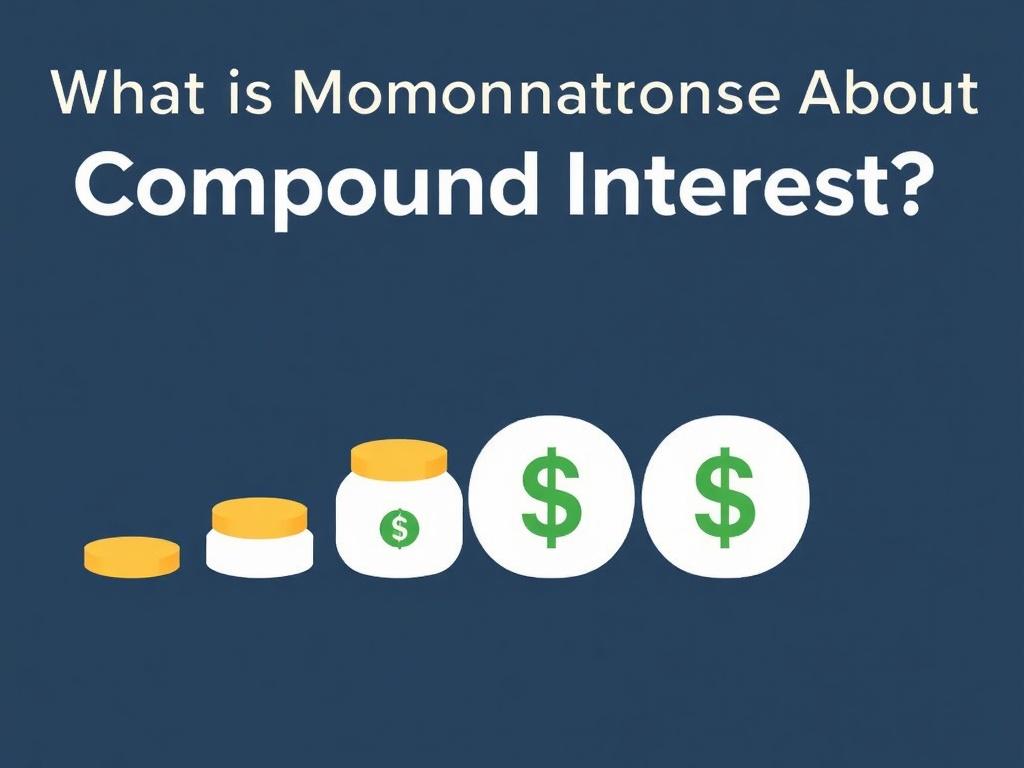SQLITE NOT INSTALLED
Investing can sometimes feel like a mysterious world filled with complex jargon and confusing terms. One phrase you’ve probably heard tossed around is “compound interest.” But what exactly is compound interest in investing, and why does it matter so much for your financial future? Simply put, compound interest is the powerful magic that turns small amounts of money into large sums over time, allowing your investments to grow exponentially. If you’ve ever dreamed of making your money work for you, understanding compound interest is the first step to unlocking this potential.
At its core, compound interest in investing means that you earn interest not only on your original investment but also on the interest that accumulates over time. This seemingly simple concept is the reason why money invested wisely can snowball into a significant fortune. Unlike simple interest, which pays interest only on the principal amount, compound interest “compounds” the returns and reinvests them, creating a cycle of growing earnings. This is a key concept to grasp, whether you’re investing in stocks, bonds, mutual funds, or retirement accounts.
Содержание
How Does Compound Interest Work?
To truly appreciate the impact of compound interest in investing, let’s break down how it actually works. Imagine you invest $1,000 in an account that earns 5% interest annually. After the first year, you earn $50 in interest, so your total becomes $1,050. Now, in the second year, your 5% interest is not just calculated on the original $1,000, but on the new balance of $1,050. This means you earn $52.50 interest the second year. Each year, the interest grows because it is calculated on an increasing balance, not just the original deposit.
Example of Compound Interest Growth
| Year | Starting Balance | Interest Earned (5%) | Ending Balance |
|---|---|---|---|
| 1 | $1,000 | $50 | $1,050 |
| 2 | $1,050 | $52.50 | $1,102.50 |
| 3 | $1,102.50 | $55.13 | $1,157.63 |
| 4 | $1,157.63 | $57.88 | $1,215.51 |
| 5 | $1,215.51 | $60.78 | $1,276.29 |
As you can see from this simple example, after five years, your initial $1,000 becomes $1,276.29 thanks to the power of compound interest. This growth may seem modest in the short term, but over decades, compound interest in investing creates extraordinary wealth.
Why Is Compound Interest Important in Investing?
Many investors underestimate the power of compound interest because it requires patience and a long-term horizon to really shine. Unlike quick, risky bets that might make or lose you money fast, compound interest rewards consistent, disciplined investing over time. Whether you’re investing for retirement, a home, or your children’s education, compound interest gives your money a chance to multiply quietly in the background.
But what makes compound interest truly extraordinary? There are several reasons:
- Time is your best ally: The longer your money stays invested, the more opportunities compound interest has to work its magic.
- Reinvestment accelerates growth: Instead of withdrawing your interest earnings, reinvesting them allows your total balance to increase rapidly.
- Small contributions add up: Even modest, regular investments can grow significantly thanks to compounding.
- It beats inflation: Over time, the compounding growth usually outpaces inflation, preserving and growing your purchasing power.
The combination of these factors makes compound interest the cornerstone of smart investing, especially for individuals who start early and stick to their plans.
Compound Interest vs. Simple Interest: What’s the Difference?
It’s helpful to understand what sets compound interest apart from simple interest to appreciate why it’s so valuable in investing. Simple interest is calculated only on the original amount of money invested, called the principal. This means the interest you earn each period stays the same, regardless of how much the total grows.
Here’s a quick comparison in table form:
| Type of Interest | Interest Calculation | Example: $1,000 at 5% for 5 years |
|---|---|---|
| Simple Interest | Interest on Initial Principal Only | $1,000 + ($50 × 5) = $1,250 |
| Compound Interest | Interest on Principal + Interest Earned | $1,276.29 (as shown earlier) |
As you can see, compound interest yields more money than simple interest over the same time period, which is why it is the preferred method in investing.
Factors Affecting Compound Interest in Investing
While the formula behind compound interest may sound straightforward, several factors influence how much your investment can grow over time. Understanding each helps you make smarter decisions and set realistic expectations.
Interest Rate
The interest rate (or rate of return) is simply how much your investment grows each period—usually annually. A higher interest rate means faster compounding, but with investing, higher potential returns usually come with higher risk. For example, stock market investments often produce higher returns on average than savings accounts but can be volatile. Balancing interest rate with your comfort level on risk is crucial.
Frequency of Compounding
Compound interest can be calculated on different schedules, such as annually, semi-annually, quarterly, monthly, or even daily. The more frequent the compounding, the faster your investment grows because interest is being added more often.
Consider this breakdown:
- Annual compounding: Interest added once per year.
- Semi-annual compounding: Interest added twice per year.
- Quarterly compounding: Interest added four times per year.
- Monthly compounding: Interest added twelve times per year.
Though the difference between annual and monthly compounding might seem small, over many years this can significantly affect your total returns.
Time Horizon
As already mentioned, time is perhaps the most important factor influencing compound interest. The power of compounding accelerates exponentially the longer you leave your investments alone and reinvest the earnings. Even small differences in investment length can lead to big differences in final amounts due to the “snowball” effect.
Amount Invested
Your initial investment amount matters, but so do any additional contributions you make along the way. Regular monthly or yearly contributions, no matter how small, can add up to surprising totals when combined with compound interest.
How to Make the Most of Compound Interest in Investing

Since compound interest is so effective, smart investors deliberately structure their investment strategy to harness its power fully. Here are practical tips to maximize your benefits from compound interest:
Start Early
When it comes to compound interest in investing, time is your ally. The earlier you start, the more compounding periods you benefit from. For example, someone investing $200 a month starting at age 25 will build much more wealth by 65 than someone who starts the same investment at age 35.
Reinvest Your Earnings
Avoid the temptation to take out interest earnings or dividends. Instead, have them reinvested automatically. This accelerates growth by constantly increasing the principal on which you earn future interest.
Be Consistent and Patient
Compound interest rewards consistent efforts and patience. Resist the urge to cash out early or change investments frequently, as fees or lost time can weaken compounding benefits.
Diversify Your Investments
Different investments earn different rates of return, and some compound interest faster than others. By diversifying your portfolio across stocks, bonds, mutual funds, ETFs, and other instruments, you balance risk with the potential for steady compounding growth.
Look for Tax-Advantaged Accounts
Investing through tax-advantaged accounts—like 401(k)s, IRAs, or Roth IRAs in the U.S.—allows your compound interest to accumulate without being taxed yearly. This means more money stays invested and compounds faster.
Common Misconceptions About Compound Interest

Despite being a fundamental concept in investing, compound interest can sometimes be misunderstood. Here are some common myths clarified:
- Myth: Compound interest means guaranteed huge returns. Reality: Compound interest grows your money over time, but the investment’s rate of return can vary, and losses are possible.
- Myth: You need a lot of money to benefit from compound interest. Reality: Even small, regular investments can generate impressive results given enough time.
- Myth: Compound interest only works with savings accounts. Reality: Compound interest applies to many types of investments, including stocks, bonds, and mutual funds if interest or dividends are reinvested.
- Myth: Compounding only matters for old investors planning retirement. Reality: Young investors especially benefit from compounding since time is the biggest multiplier.
The Mathematics Behind Compound Interest

For those curious about the formula, compound interest in investing is calculated using this equation:
A = P (1 + r/n)^(nt)
Where:
| A | The amount of money accumulated after n years, including interest. |
| P | The principal investment amount (initial deposit or loan amount). |
| r | The annual interest rate (decimal). |
| n | The number of times interest is compounded per year. |
| t | The number of years the money is invested or borrowed. |
By plugging your investment details into this formula, you can calculate how your money will grow with compound interest.
Try a Compound Interest Calculator
Many financial websites offer free compound interest calculators, which are great tools to experiment with different rates, durations, and investment amounts to plan your investing goals.
Real-Life Examples of Compound Interest in Investing
To really breathe life into the concept, let’s look at real-life examples of how compound interest benefits everyday investors.
- Retirement Savings: Jane started investing $300 a month at age 25 with an average 7% annual return. By the time she retired at 65, her investment grew to over $700,000—thanks to the power of compound interest, turning what she put in into a comfortable nest egg.
- College Fund: A couple invests a lump sum for their newborn’s college, and compound interest helps that money nearly double every decade, making the final tuition expenses more manageable.
- Dividend Reinvestment Plans (DRIPs): Many companies offer DRIPs that automatically reinvest dividends to buy more shares. This enables shareholders to benefit from compound interest as dividends generate additional shares that create future earnings.
When Compound Interest Doesn’t Work As Expected
While compound interest is powerful, there are scenarios where it might underperform or even work against you.
- High Fees and Taxes: Investment fees and taxes can eat into returns and diminish the benefits of compounding.
- Withdrawals: Taking money out of your investments interrupts the compounding cycle, delaying growth.
- Low or Negative Returns: If your investments don’t generate positive returns, compound interest won’t help your money grow.
- Inflation: Sometimes the growth from compound interest is not enough to outpace inflation, reducing purchasing power.
Being aware of these pitfalls helps you plan better and protect your investments.
Summary Table: Compound Interest Benefits vs. Challenges
| Benefits | Challenges |
|---|---|
| Accelerates investment growth over time | Time and patience required |
| Helps beat inflation | Returns can be volatile in the short term |
| Works with many types of investments | Fees and taxes reduce net compounding |
| Works best with consistent contributions | Early withdrawals disrupt compounding |
Conclusion
Understanding what compound interest in investing means and how it works is essential for anyone looking to grow their wealth consistently and effectively. This seemingly simple concept turns modest investments into substantial sums over time, rewarding patience, consistency, and smart reinvestment choices. Whether you’re just starting out or revisiting your financial strategy, embracing compound interest—and all its nuances—can transform your approach to investing. The key lies in starting early, staying disciplined, and harnessing compounding’s exponential potential to meet your long-term financial goals. By appreciating the power of compound interest, you’re putting yourself on a path to financial freedom that few other strategies can offer.
Опубликовано: 23 July 2025 Кредитрон – блог о кредитах, финансах и прочих реверансах
Кредитрон – блог о кредитах, финансах и прочих реверансах

